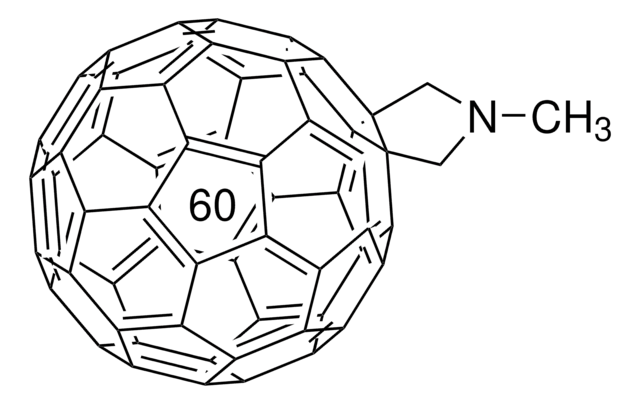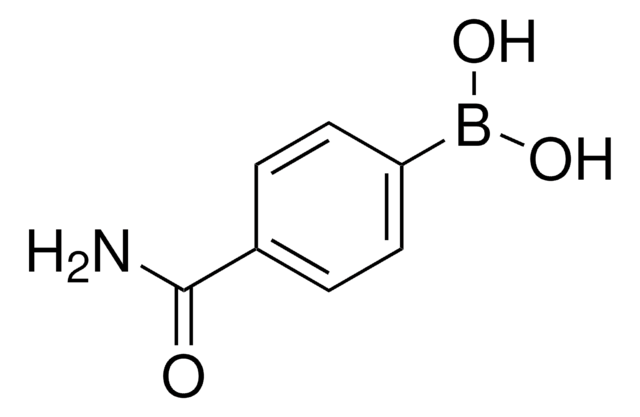684503
[6, 6]-Pentadeuterophenyl C61 butyric acid methyl ester
99.5%, 99.5 atom % D
Synonyme(s) :
1-[3-(Methoxycarbonyl)propyl]-1-pentadeuterophenyl-[6.6] C61, 3′-(Phenyl-d5)3′H-cyclopropyl[1, 9] [5, 6] fullerene-C60-Ih-3′-butanoic acid methyl ester, d5-[60]PCBM
About This Item
Produits recommandés
Description
functionalized fullerene
Pureté isotopique
99.5 atom % D
Pureté
99.5%
Forme
powder
Changement de masse
M+5
Chaîne SMILES
[2H]c1c([2H])c([2H])c(c([2H])c1[2H])C2(CCCC(=O)OC)[C]3=4c5c6c7c8c9c%10c(c%11c%12c3c%13c5c%14c%15c6c%16c7c%17c9c%18c%19c%10c%20c%11c%21c%12c%22c%13c%23c%14c%24c%15c%25c%16c%26c%17c%18c%27c%28c%19c%20c%29c%21c%30c%22c%23c%31c%24c%32c%25c%26c%27c%33c%28c%29c%30c%31c%32%33)[C]2=48
InChI
1S/C72H14O2/c1-74-11(73)8-5-9-70(10-6-3-2-4-7-10)71-66-58-50-40-30-22-14-12-13-16-20-18(14)26-34-28(20)38-32-24(16)25-17(13)21-19-15(12)23(22)31-37-27(19)35-29(21)39-33(25)43-42(32)52-46(38)56-48(34)54(44(50)36(26)30)62(66)64(56)68-60(52)61-53(43)47(39)57-49(35)55-45(37)51(41(31)40)59(58)67(71)63(55)65(57)69(61)72(68,70)71/h2-4,6-7H,5,8-9H2,1H3/i2D,3D,4D,6D,7D
Clé InChI
FIGVSQKKPIKBST-QRKCWBMQSA-N
Description générale
Application
Mention d'avertissement
Warning
Mentions de danger
Conseils de prudence
Classification des risques
Eye Irrit. 2 - Skin Irrit. 2 - STOT SE 3
Organes cibles
Respiratory system
Code de la classe de stockage
11 - Combustible Solids
Classe de danger pour l'eau (WGK)
WGK 3
Point d'éclair (°F)
Not applicable
Point d'éclair (°C)
Not applicable
Équipement de protection individuelle
dust mask type N95 (US), Eyeshields, Gloves
Faites votre choix parmi les versions les plus récentes :
Déjà en possession de ce produit ?
Retrouvez la documentation relative aux produits que vous avez récemment achetés dans la Bibliothèque de documents.
Les clients ont également consulté
Articles
Since the first publication in 1995 describing a bulk heterojunction photodiode incorporating a methanofullerene, significant progress has been made in improving device performance and the scope of device research has broadened widely.
PCBM-based n-type semiconductors - Find p- and n-type organic semiconductors available with PCBM library & properties.
Find various photovoltaic and bioscience-based applications of fullerenes.
Single-walled carbon nanotubes (SWCNTs) are promising materials for use in the active channel of field-effect transistors (FETs), photoabsorbing layers of solar cells and photodetectors because of their ultrafast charge transport mobility.
Notre équipe de scientifiques dispose d'une expérience dans tous les secteurs de la recherche, notamment en sciences de la vie, science des matériaux, synthèse chimique, chromatographie, analyse et dans de nombreux autres domaines..
Contacter notre Service technique
![[6,6]-Phenyl C61 butyric acid methyl ester ≥99%](/deepweb/assets/sigmaaldrich/product/structures/359/221/d990c746-0960-4c69-bf76-fe09b193824d/640/d990c746-0960-4c69-bf76-fe09b193824d.png)
![4-(1′,5′-Dihydro-1′-methyl-2′H-[5,6]fullereno-C60-Ih-[1,9-c]pyrrol-2′-yl)benzoic acid](/deepweb/assets/sigmaaldrich/product/structures/417/736/540e4dd8-0c87-48e5-8307-3befb16498ba/640/540e4dd8-0c87-48e5-8307-3befb16498ba.png)


![[6,6]-Phenyl C71 butyric acid methyl ester 99%](/deepweb/assets/sigmaaldrich/product/structures/716/624/9fb9f2f0-ae99-429f-8d3a-b12267976a4d/640/9fb9f2f0-ae99-429f-8d3a-b12267976a4d.png)
![[6.6] Diphenyl C62 bis(butyric acid methyl ester)(mixture of isomers) 99.5%](/deepweb/assets/sigmaaldrich/product/structures/213/478/93c26667-6556-40bb-8cbe-350bdbabfc00/640/93c26667-6556-40bb-8cbe-350bdbabfc00.png)


